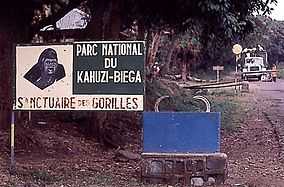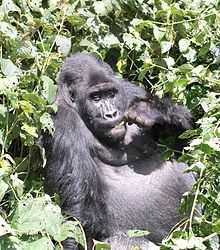Kahuzi-Biéga National Park
| Kahuzi-Biéga National Park | |
|---|---|
|
IUCN category II (national park) | |
 Park entrance | |
 | |
| Location | Democratic Republic of the Congo |
| Coordinates | 2°30′0″S 28°45′0″E / 2.50000°S 28.75000°ECoordinates: 2°30′0″S 28°45′0″E / 2.50000°S 28.75000°E |
| Area | 6,000 km² |
| Established | 1970 |
| Governing body | l'Institut Congolais pour la Conservation de la Nature (ICCN) |
| Type: | Natural |
| Criteria: | x |
| Designated: | 1980 (4th session) |
| Reference No. | 137 |
| State Party: | Democratic Republic of the Congo |
| Region: | Africa |
| Endangered: | 1997–present |
The Kahuzi-Biega National Park is a protected area near Bukavu town in eastern Democratic Republic of the Congo. It is situated near the western bank of Lake Kivu and the Rwandan border. Established in 1970, the park is named after two dormant volcanoes, Mount Kahuzi and Mount Biega, which are within its limits. With an area of 6,000 square kilometres (2,300 sq mi), Kahuzi-Biega is one of the biggest national parks in the country. Set in both mountainous and lowland terrain, it is one of the last refuges of the rare species of Eastern lowland gorilla (Gorilla beringei graueri), an endangered category under the IUCN Red List. The park is a UNESCO World Heritage Site, inscribed in 1980 for its unique biodiversity of rainforest habitat and its eastern lowland gorillas.
Geography
The park lies west of the Bakavu town in South Kivu Province,[1] covering an area of 6000 km2. A small part of the park is in Mitumba Mountain range of the Albertine Rift in the Great Rift Valley, and the larger part is in lowland terrain.[2] A corridor of 7.4 kilometres (4.6 mi) width separates the mountainous and lowland terrain.[1] The eastern part of the park is the smaller mountainous region measuring 600 square kilometres (230 sq mi); the larger part measures 5,400 square kilometres (2,100 sq mi) and consists mainly of lowland stretching from Bukavu to Kisangani, drained by the Luka and Lugulu rivers which flow into the Lualaba River.[2] Two dormant volcanoes are set within the park's limits and lend their names to it: Kahuzi (3,308 metres (10,853 ft)) and Beiga (2,790 metres (9,150 ft)).[1]
The park receives an average annual precipitation of 1,800 millimetres (71 in). The maximum temperature recorded in the area is 18 °C (64 °F) while the minimum is 10.4 °C (50.7 °F).[3]
Legal status
The earliest reserve, Zoological and Forest Reserve of Mount Kahuzi, was created on 27 July 1937 by the then Governor General of the Belgian Colonial administration.[3] That reserve has been part of the Kahuzi-Biega National Park since November 1970. Five years later, the park was extended to cover 6000 km2.[4] The park was declared a UNESCO World Heritage Site in 1980,[2] under Criterion (x) for its unique habitat of rainforest and diversity of the mammal species, particularly the eastern lowland gorillas, Gorilla beringei graueri.[2]
Flora and fauna
The park has a rich diversity of flora and fauna and provides protection to 1,178 plant species in the mountainous region of the park, with some 136 species of mammals 349 species of birds, as of 2003.[2]
Flora
The larger lowland area of the park is dominated by the rain forest (Guineo-Congolian) vegetation typical of tropical Africa. There is a transition zone of mixed rain forest and Afro-montane vegetation between the lowlands and where the montane vegetation begins.[3] Tree heathers dominate this transition zone. Both montane and bamboo forests grow at higher elevations. Sub-alpine vegetation of heather and the endemic Senecio kahuzicus grows above 2,600 metres (8,500 ft) near the summits of the volcanoes. Riparian forest and marshlands occur near watercourses at all elevations in the park, and there are also rare swamps and bogs.[2]
Fauna

Among the 136 species of mammals identified in the park, the eastern lowland gorilla is the most prominent. According to a 2008 status report of the DR of Congo, the park had 125 lowland gorillas, a marked reduction from the figure of 600 gorillas of the pre-1990's conflict period, and consequently the species has been listed in the endangered list. The park is the last refuge of this rare species.[5] According to the census survey of eastern lowland gorillas reported by the Wildlife Conservation Society in April 2011, at least 181 gorillas were recorded in the park.[6]
Other primates include the eastern chimpanzee, and several Cercopithecinae, Colobinae and owl-faced monkey. Some of the mammals include the bush elephant, bush buffalo, hylochere and bongo, Aquatic civet, eastern needle-clawed galago, Maclaud's horseshoe bat, Ruwenzori least otter shrew, and Alexander's bush squirrel.[2]
The endangered species of fauna listed under the IUCN Red List include:[2]
- Tragelaphus eurycerus (Bongo)
- Syncerus caffer nanus (Forest Buffalo)
- Loxodonta cyclotis (Forest Elephant)
- Hippopotamus amphibius (Hippopotamus)
- Hylochoerus meinertzhageni (Forest Hog)
- Panthera pardus (Leopard)
- Glaucidium albertinum (Albertine Owlet)
- Micropotamogale ruwenzorii (Rwenzori Otter Shrew)
- Pan troglodytes schweinfurthii (Eastern chimpanzee)
- Papio anubis (Anubis Baboon)
- Dendromus kahuziensis (Mount Kahuzi African Climbing Mouse)
- Rhinolophus maclaudi (Maclaud's Horseshoe Bat)
Avifauna on the IUCN Red List are also mentioned:[2]
- Prionops alberti (Yellow-crested Helmet-shrike)
- Afropavo congensis (Congo Peafowl)
- Pseudocalyptomena graueri (African Green Broadbill)
- Nectarinia rockefelleri (Rockefeller's Sunbird)
Conservation
The park, under the management of the Institut Congolais pour la Conservation de la Nature, has a basic management and surveillance structure. However, the park's 1975 expansion, which included inhabited lowland areas, resulted in forced evacuations with about 13,000 people of the tribal community of Shi, Tembo and Rega affected and refusing to leave.[2] Cooperation by the communities living around the park and employment of the Twa people to enforce park protection was pursued by the park authorities. In 1999, a plan was developed to protect the people and the resources of the park.[7]
References
- ↑ 1.0 1.1 1.2 Barume 2000, p. 68-.
- ↑ 2.0 2.1 2.2 2.3 2.4 2.5 2.6 2.7 2.8 2.9 "Kahuzi-Biega National Park". UNESCO. Retrieved 27 October 2013.
- ↑ 3.0 3.1 3.2 Barume 2000, p. 68.
- ↑ Barume 2000, p. 70.
- ↑ "Kahuzi-Biega National Park". World Heritage Site Organization. Retrieved 28 October 2013.
- ↑ "Gorillas surviving against the odds in Kahuzi-Biega". Gorilla Organization. 21 April 2011. Retrieved 28 October 2013.
- ↑ Barume 2000, pp. 72-77.
- Bibliography
- Barume, Albert Kwokwo (2000). Heading Towards Extinction?: Indigenous Rights in Africa : the Case of the Twa of the Kahuzi-Biega National Park, Democratic Republic of Congo. IWGIA. ISBN 978-87-90730-31-4.
External links
![]() Media related to Kahuzi-Biega National Park at Wikimedia Commons
Media related to Kahuzi-Biega National Park at Wikimedia Commons
| |||||